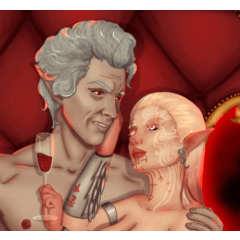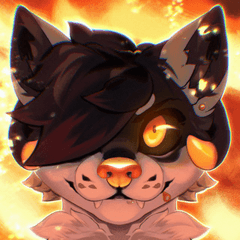Let's Learn Composition!
In this tutorial, learn how to incorporate factors such as color, positioning, and perspective into your illustrations to achieve great composition for your art!
Intro
Hello, all! My name is Dreamer! Welcome!
In this month’s tutorial, I will be teaching you things to consider when composing your illustrations! I dabbled in this topic last month, but now I get to go more in depth about things other than flowers that you may want to consider when making up a composition for your art!
I’m excited to teach you what I know, so let’s get started!
Positioning Your Characters! Rule of Thirds!
This is arguably the most important factor in regard to making appealing compositions for your character illustrations. When thinking about where your character should be on the canvas, you need to keep in mind where other elements will be, such as things or people in the background. This is to make sure that your main focal point isn’t drowned out.
The method I love to use is the Rule of Thirds, because it is a simple way to position your characters that effectively works to bring them into focus, if you draw all the other elements accordingly!
I can really show it to you better than explaining it, but the Rule of Thirds is basically two vertical lines divided with two horizontal lines to make a bunch of squares in the middle. I’ve found the best points of focus are on t
You could always place your character directly in the center of the drawing and make sure that the objects and background don’t compete with the character’s height and importance, though!
Or you could use shapes! With shapes like triangles and circles, you can create a flow of interest that will eventually bring the viewer’s eyes to the focal point, which is your character! This can also come in handy when figuring out the perspective of your character art, which I will explain later on in this article!
Example Time!
Let’s say we had this illustration here of a crowd of people, but we want the main character (in this case my OC Yiska, who's facing the opposite direction) to stand out amongst them. We can make that happen using the Rule of Thirds!
First things first, I’m going to make a new layer, then use Clip Studio’s linear ruler to draw two vertical lines and two horizontal lines (you can draw straight rulers and lines by pressing shift as you drag the stylus, mouse, etc.)
Once I have the rulers placed, I’m going to draw the lines that are created by the rulers. I have to do this, because if I don’t, the rulers will go away when I change back to my main character’s layer.
Then, I’ll lower the opacity of the ruler layer and position my character accordingly! You can either use the move icon (the crosshair-looking button) or use the lasso tool and move them (the scale button on the tab that pops up when the item is selected with the lasso tool)!
And just like that, your character is in even more focus than before, because they’re standing apart from the crowd!
But the crowd is still contesting with Yiska, as it falls on a section of the rule of thirds. We can use another aspect of composition to bring even more focus to him!
Let’s keep reading and see what it is!
Contrast!
This may not seem very important, but contrast can do a lot in terms of deciding what you want to stand out in your art. So, if you want your character to stick out above all else in the drawing, it’s important to consider how you can bring them out in terms of them contrasting with their environment!
I will be teaching you the color aspects of contrast! Do you want the character to be desaturated, and the rest saturated? Do you want them to be warm, and the others to be cool? Do you want them to be darker colored, and the rest to be lighter colored?
These are things to consider when choosing the colors for your illustrations!
We’re going to continue with my illustration of my OC, but first, I’m going to explain a little color theory to you as best as I can!
A Little Color Theory!
There are your warm colors (red, orange, yellow), and there are your cool colors (blue and purple). Green can be warm or cool, depending on how much yellow or blue you add into it.
When coloring an illustration, I tend to think on how I can get the character to complement the colors of the background yet stick out from it. This is why I tend to use the complementary color scheme, as choosing one color will automatically set you up with a range of color on the opposite side of the color wheel that will create a natural contrast for your character.
Red is complementary to green, blue is complementary to orange, yellow is complimentary to purple, and so on.
This color scheme helps the viewer understand what the main focus of the artwork is, because nine times out of ten, the character will be the complementary color to whatever the environment is, automatically bringing contrast and a sharper focus on what’s important in the illustration!
Example Time!
Let’s get back to my illustration with Yiska! Since he is the main point of focus in this illustration, I have decided to make the color of the crowd blue and make him orange, since orange naturally contrasts from blue. Afterwards, I made the background color a light, faint blue, to further place emphasis on the fact that Yiska doesn’t fit in his environment (which is the goal!).
I also used Gaussian Blur to further place emphasis on his position. This can help the viewer understand that the things within the blur aren’t meant to be the main focus in the illustration! It also helps you understand what you should and should not put a lot of detail and focus into!
Tip!
Use bounce lighting! That way the characters still fit into the environment, and it won’t look terribly unnatural! I explained it a little bit in my first article, but it’s basically a weaker shade of the character’s environment color. Like a red ball being in green grass will have a faint shade of green in its shadows. But remember! It’s not as strong as the direct light source, so the color is faint!
And with that, we’re done learning about coloring! Good job!
Continue to think of ways you can make your character stand out with color! I promise it adds a magical, appealing quality to your artwork! You’ll be pleased with how quickly your eyes snap to the focal point!
Now, then. We’ve explored how positioning and coloring the character can make them stand out in an illustration. But there’s one more thing you can consider to have them stand out even more!
Let’s read on and find out what it is!
Perspective and Shapes!
This can tie into the pose/position tip, and even the color tip from earlier. Perspective can help add another level of focus and interest to your illustration! Then, using composition rules like the rule of thirds I mentioned above and shapes (which is what I’m about to go over), you can position them accordingly to get the best level of focus, and then color them with a complimentary color from the background to even further indicate their importance, like I mentioned in the color section of this tutorial!
Do you want the character to be viewed from above, or below? To the side while above/below, or in the center while above/below? Where do you want the viewer’s eyes to be drawn to?
Just like with figuring out the positioning of your character, you can use shapes to figure out the perspective of the character as well! With shapes like rectangles/boxes and triangles, you can figure out the “depth” of the character, if you will! That is, you can figure out where the head goes, and the bottom of the feet as well! This helps make sure you’ve got the character in a natural view of perspective!
Now, then: how do the shapes work? It’s the same as the Rule of Thirds; it helps you position your character in a way that will bring as much focus to them as possible! You can either have the shapes leading up to the character, or you can have the character surrounded by the shape to single them out! It’s pretty fun coming up with ways to use shapes for composition!
After you’ve figured out where your character will be with the shape of the composition, the boxes will help with the perspective! So, like, the shape of the composition tells you where they will go or how they are positioned, and then the box will further emphasize how dramatic the perspective of the character will be!
Examples!
You’ll still need a little bit of knowledge when doing this in terms of the human body, like how far the arms go, the position of the shoulders, etc. But once you understand those well enough, you’ll be able to do these with ease! And soon enough, you may not even need the boxes!
You can also use Clip Studio’s perspective ruler to help you, too, and even their 3D models! Just position the models how you want them to stand, and use them as a reference, or draw over them! That’s probably way easier than trying to figure it out by trial and error!
The Coiling Method!
You can also use the coiling technique to help you with things like foreshortening! Basically, you draw a spring-like shape in the direction you need the character’s arm or legs to face, and then sketch over it.
This can really help you if you’re struggling with drawing parts of the body in perspective!
Tip!
Look at references!! I promise you that they can help you figure out how things work and where they should go! And they help you store a mental library of information regarding what you’re drawing and observing; so, after a while, you won’t even need to see references anymore, the more proficient you get at drawing the subject of choice!
Using perspective is so fun, especially when making character illustrations! Try it out and see how you like it! It can make your drawings interesting!
Outro
I hope this article helps you! Don’t take my advice as the only way to do this, though; try out other methods and techniques to find the one you like! Just be sure to give credit to all the artists you’ve learned from; shout out to all the ones I’ve studied, took inspiration from, read, and observed!
Continue to make great art, and I will see you all next time!





















Comment